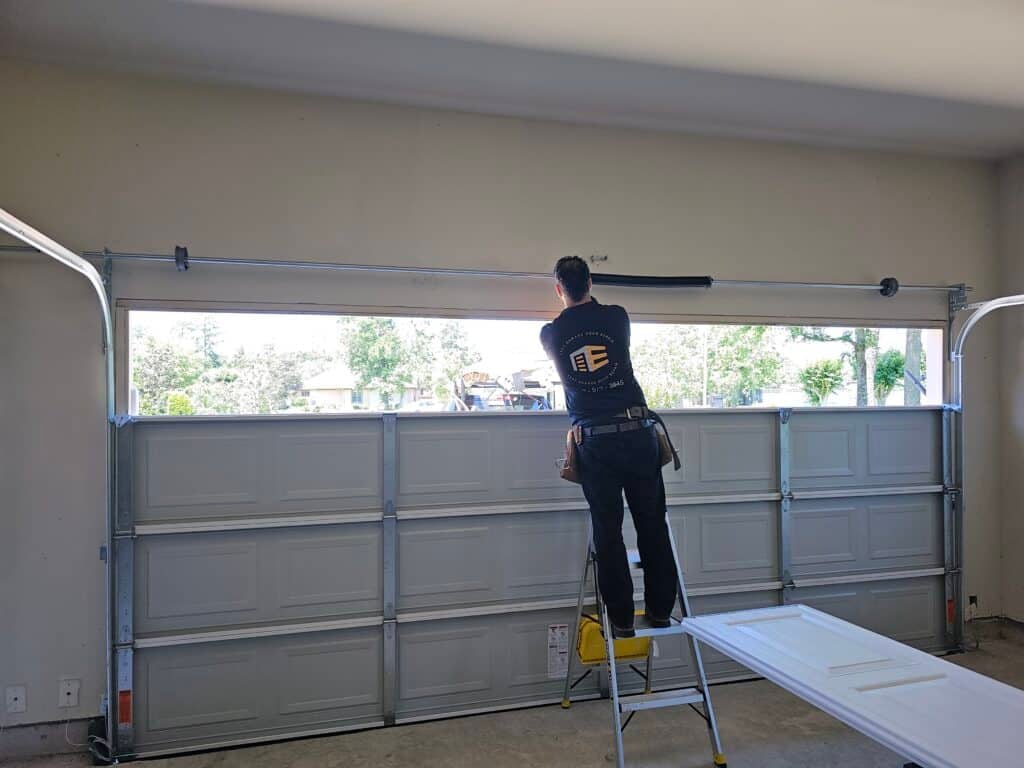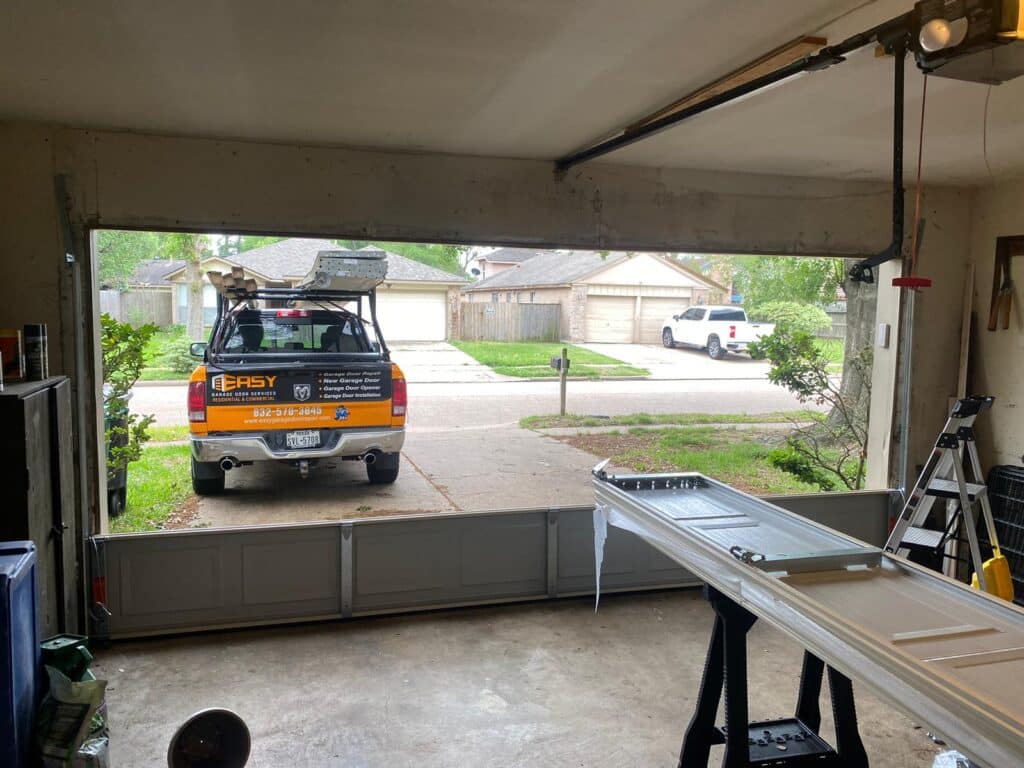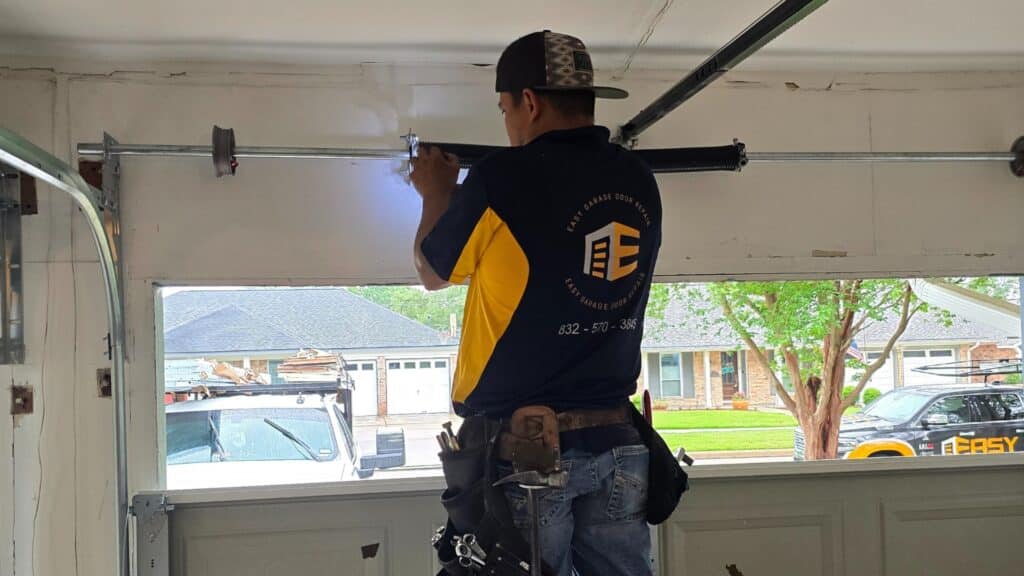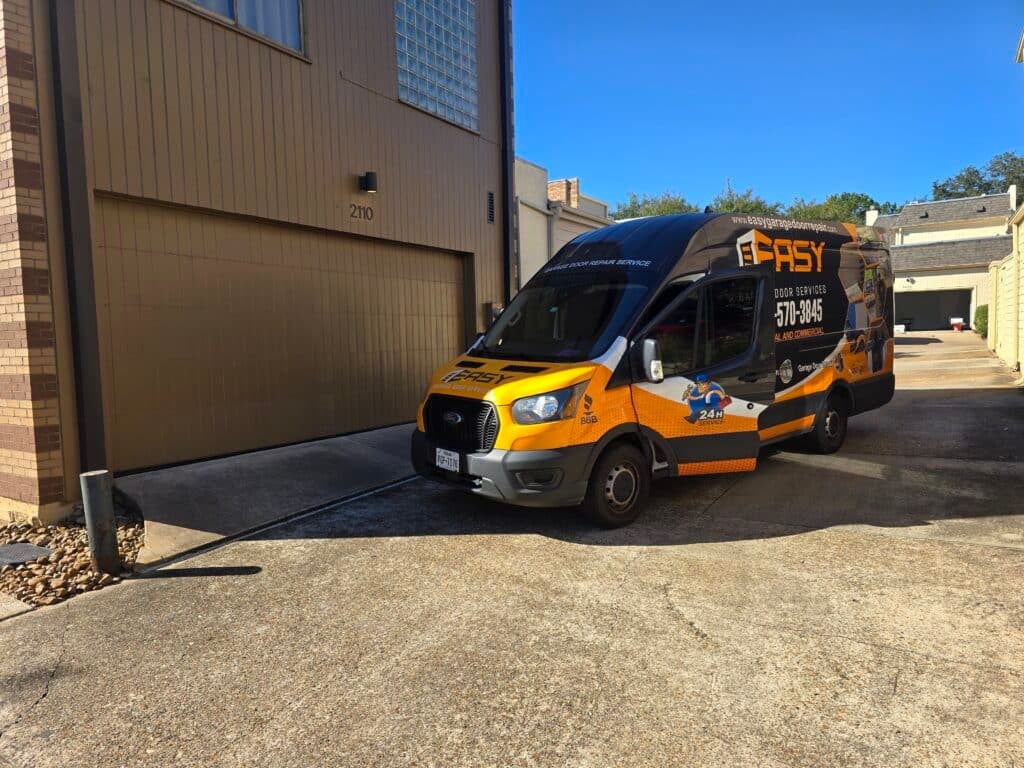Doors in commercial facilities take a relentless beating day after day. They are used constantly, meaning that if they have any kind of mechanical or operational issue (and many do), that issue is pretty much guaranteed to get worse over time. If your office building, retail store, or industrial facility has door problems, those problems are impacting business and stand a good chance of affecting both security and safety. Indeed, door-related problems are a trifecta of bad business.
In this guide, you’ll get familiar with the most frequent commercial door problems, learn to identify early warning signs, and find practical solutions to keep your doors functioning smoothly. We’ll help you determine which repairs you can handle yourself and when it’s time to call in professional technicians.
Common Commercial Door Problems and How to Fix Them
Constant heavy traffic and environmental factors stress commercial doors, leading to a variety of operational issues that require prompt attention. Understanding the nature of these problems and their solutions enables you to maintain the functional integrity of your doors and to avoid emergency repairs.
Commercial Door Alignment Issues
Door alignment problems occur when doors hang incorrectly in their frames, creating gaps, binding, or difficulty operating.
Commonly, this issue is caused by settled building, worn-out hinges, or damaged frames. Look for these signs:
• Doors that don’t close.
• Gaps that are too big to be good.
• Sounds that make it seem like something is trying to resist closing.
How to Spot
- Inspect the door and frame for consistent spacing on all four sides. Uneven gaps can indicate an issue with the door or frame.
- Search for openings that errors of construction allow to operate as doors, swinging open or closed by themselves because of gravity.
- Understand whether the door needs to be lifted, pushed, or pulled to ensure it latches correctly.
- Check the door’s top and bottom for indications of rubbing or worn paint.
- Inspect it where it makes contact with the frame or floor.
- Look for excessive wear, and note any rubbing marks you’ve found.
- Check if the deadbolt or latch fails to align with the strike plate hole, requiring force to engage.
- Check for stressed fissures in the paint or in the caulking around the joints of the frame.
Solution for Alignment Issue
- To correct alignment problems, start by checking the hinges for loose screws or any sign of wear.
- Use a screwdriver to tighten all hinge screws and replace any that are too stripped to hold (the new screws should be longer).
- If the door still gapped, it was time to add some shims to the hinges.
- And then you might as well add more screws if you’re going to use shims anyway. Because shims and screws are the two things you use when you don’t want to plane a door.

Loose or Damaged Door Handles
Door handles on commercial doors are used thousands of times every day. They’re designed to be used. But even the best commercial door handles can wear out over time and become loose or wobbly. And when they reach the point at which a company can’t use them anymore, either because they’re not safe or not secure, that’s a problem.
How to Spot
- Inspect door handles for signs of looseness.
- Check for handles that wiggle when touched, visible gaps between the handle and door surface, or difficulty turning the handle mechanism.
- Listen for rattling sounds when the door moves, indicating loose internal components.
Solution for Damaged Door Handles
- To fix loose handles, take off the handle assembly and tighten all the screws that mount the assembly.
- If any screws are worn, replace them with commercial-grade hardware that is rated for use in high-traffic areas.
- In any case where the handle mechanism is simply no longer working and is too far gone to be repaired, install a new heavy-duty handle that is designed to survive in a commercial environment.
Improper Threshold Sealing
Drafts, water, and pests enter your building through faulty threshold seals, and they take with them a lot of energy that could otherwise be saving you money. Increasing your door’s energy efficiency in cold weather could result in savings of up to 23%. That’s a lot, especially since the World Bank Group estimates that the United States spends around $4.50 per person on electricity and natural gas.
How to Spot
- Inspect for visible light shining through gaps around or beneath the door when observed from a darkened room.
- Check for signs of water intrusion, such as stains, puddles, or moisture damage near the door threshold following rainfall.
- Detect drafts by running your hand along the edges and bottom of the door.
- Pay attention to any noticeable increase in outside noise levels near the door compared to other areas.
- Evaluate the condition of weather stripping for any cracks, tears, compression, or detachment from the door frame.
- Look for the presence of dirt, debris, or pest droppings near the base of the door, which may reveal potential entry points.
- Review energy bills for sudden, unexplained increases that could signify air leakage.
- Lastly, inspect door sweeps for damage, such as bent, torn, or missing sections, which may prevent proper sealing with the threshold.
Solution for Improper Threshold Sealing
- Check the threshold. You can do this by looking for light coming through, feeling for drafts, or checking for any water stains that may be present.
- Reinstall compromised weather stripping using top-tier materials like commercial-grade EPDM rubber or silicone.
- Install new door sweeps that maintain positive contact with the threshold without interfering with door operation.
- Change the threshold height if necessary to create a proper seal.
Commercial Door Frame Damage
Frame damage compromises door security and operation, often resulting from impacts, moisture exposure, or structural settling. Damaged frames prevent proper door closure and create security risks.
How to Spot
- Watch for doors that fail to detect approaching people or activate only when someone is extremely close to the sensor.
- Notice if doors open randomly without anyone nearby or remain open longer than programmed.
- Check for jerky, stuttering movements during operation or doors that stop mid-cycle.
- Listen for unusual motor noises like grinding, whining, or clicking sounds.
- Observe if the door closes too rapidly, creating safety hazards, or moves unusually slowly.
- Look for visible damage to sensor eyes or dirt buildup on sensor surfaces.
- Test if the safety features fail to reverse the door when encountering obstacles.
- Monitor for frequent activation of manual override systems or staff complaints about inconsistent operation.
Solution for Frame Damage
- Examine frames for cracks, rot, or separation from the wall. Minor damage requires filling cracks with wood filler or caulk, then sanding and repainting.
- For metal frames, use auto body filler for small dents. Severe damage necessitates frame replacement or reinforcement with steel plates.
- Address any moisture sources to prevent recurring damage.

Automatic Door Malfunctions
Automatic doors depend on sensors, motors, and control systems, which can experience malfunctions caused by dirt buildup, electrical faults, or mechanical wear. Frequent issues include doors failing to open, closing too quickly, or functioning inconsistently.
How to Spot
- Monitor doors that do not detect individuals approaching or only activate when someone is very close to the sensor.
- Identify instances where doors open unexpectedly without anyone nearby or remain open longer than their programmed settings.
- Pay attention to any jerky or irregular movements during operation, as well as doors that halt mid-cycle.
- Listen for abnormal motor sounds, such as grinding, whining, or clicking.
- Evaluate whether the door closes too quickly, posing safety risks, or operates at an unusually slow pace.
- Inspect for visible damage to sensor components or dirt accumulation on sensor surfaces.
- Test the functionality of safety features to ensure the door reverses upon encountering obstacles.
- Additionally, track frequent activation of manual override systems or reports from staff regarding inconsistent performance.
Solution for Door Malfunctions
- A soft cloth and a mild cleaner are what you should use to clean the sensor lenses.
- Dirt and debris don’t stand a chance against this assassination team.
- Examine power connections and make certain that the voltage supply is adequate.
- Calibrate sensor range and sensitivity settings as per the manufacturer’s specifications.
- Use the correct lubricants on the door tracks and moving parts.
Failing Electronic Access Control Systems
Access control systems, including card readers, keypads, and biometric scanners, can malfunction due to connectivity issues, power problems, or component wear. These failures disrupt security protocols and employee access.
How to Spot
- Look for inconsistent reader responses where cards or credentials work intermittently or require multiple attempts.
- Notice if LED indicators show unusual patterns, stay constantly red, or fail to light up at all.
- Check for delayed responses between credential presentation and door unlock.
- Listen for missing beep confirmations or unusual clicking sounds from the locking mechanism.
- Watch for error messages on keypads or readers displaying communication failures.
- Test if the system fails to log entries properly or if authorized users report frequent access denials.
- Observe whether backup power systems activate frequently or if the system loses programmed settings after power interruptions.
Solution for Failing Electronic Access Control
- Verify power supply to all system components and check wiring connections for damage. Clean card readers and scanner surfaces regularly.
- Reset the system by powering off for 30 seconds before restarting.
- Update system firmware and software to address known bugs.
- For persistent issues, contact your access control vendor for diagnostic support.

Broken Springs & Cables
Commercial doors with springs and cables face significant stress, leading to component failure that prevents proper operation. Broken springs create serious safety hazards due to stored tension.
How to Spot
- Be attentive to doors that seem to have suddenly gained weight or that will only stay open partway when you want them to stay open all the way. These are signs that something might be wrong.
- When you hear loud banging or snapping noises, heed their warning. Somehow, it’s the door’s way of saying it’s an imminent danger and may need to be replaced.
- Inspect springs visually for gaps, separation, or coil elongation.
- Inspect cables for wear and tear, rust, or loose connections at attachment points.
- Pay attention to the door if it shuts too fast, smacks shut, or swings funny when one tries to get in or out.
- Examine cables that seem to be loose or have fallen off their spools or sheaves.
Call Pros for the Broken Springs Solution
Never attempt spring or cable repairs yourself due to injury risk. Contact our certified technicians immediately when you notice doors that won’t stay open, unusual noises during operation, or visible cable fraying. Our professional technicians safely replace springs and cables using proper tools and safety equipment. Call us at 832-570-3845.
Misaligned Doors
Misalignment represents one of the most frequent commercial door problems, causing operational difficulties and security vulnerabilities. Building settling, temperature changes, and regular use contribute to this issue.
How to Spot
- Search for apparent spaces between the door and frame that seem inconsistent from one side to the other.
- Examine the top, middle, and bottom portions of the door and frame for alignment.
- Determine whether the door tends to stick, drag, or need great force to open or close.
- Be aware if the door does not latch securely or seems to pop open after it is shut.
- Scrutinize the edges of the door for any evidence of scraping that might indicate a contact point with the frame or the floor.
- Check the swing of the door. A door that swings by itself or doesn’t stay put when partially opened may be out of adjustment or defective.
Solution for Misaligned Doors
- Address misalignment by examining hinge placement and tightness.
- Remove one hinge at a time to install cardboard or plastic shims for minor adjustments.
- Verify the door frame remains square using a level.
- Adjust strike plates to accommodate slight door movement.
- For persistent problems, consider professional frame realignment.
Faulty Door Closers
Door closers control how fast the door closes, and they ensure that the door latches properly when it’s supposed to. But they are not infallible. They can leak hydraulic fluid, or they can have valves that are worn out or, sometimes, just plain wrongly adjusted. When a door slams shut, or when a door just won’t close all the way, it’s a pretty good indicator that the closer itself is the problem.
How to Spot
- Look for leaks of hydraulic fluid near the closer body, doors that are shutting too quickly or too slowly, or closers that don’t pull the doors all the way shut.
- Verify the door’s action by swinging it open to its full extent and watching the closing sequence.
Solution for a Faulty Door
- To bring valves closer into alignment, use the manufacturer’s specifications, which often say to use a hex key or screwdriver to adjust them.
- The sweep speed valve controls how fast the main part of the door closes, and the latch speed valve controls how fast the final part of the door closes.
- If there are external pivot points where the closer attaches to the door and frame, see if those could use a little bit of cleaning or a drop of oil. Indeed, if a closer is leaking, or if it is leaking internally, or if it is making strange noises (which a closer should never do), replace the closer.
- When replacing a closer, be sure to select one that is rated for the weight and usage frequency of your particular door.

Sum Up
Commercial doors face numerous challenges that can compromise security, safety, and energy efficiency. From misaligned doors and broken springs to malfunctioning access control systems and worn threshold seals, these issues require prompt attention to prevent costly damage and maintain smooth business operations. While some minor problems can be addressed with basic maintenance, many commercial door issues demand professional expertise to ensure proper diagnosis and lasting solutions.
Don’t allow garage door problems to disturb your business or endanger your building’s security. Easy Garage Door Repair is an expert in commercial door services; you could even say we specialize in such. Our technicians are experienced and efficient, and they understand the unique demands of commercial properties.
24/7 emergency garage door repair service; access control problems; automatic door sensors; structural alignment issues; and the biggie that encompasses all the little issues: maintaining these systems and keeping them from breaking down.








